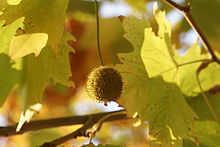Platanaceae
| Platanaceae Temporal range: Cretaceous - Recent |
|
|---|---|
 |
|
| Inflorescence of Platanus × hispanica | |
| Scientific classification | |
| Kingdom: | Plantae |
| Clade: | Angiosperms |
| Clade: | Eudicots |
| Order: | Proteales |
| Family: |
Platanaceae T. Lestib. |
| Genera | |
|
|
The Platanaceae are a family of flowering plants belonging to the order Proteales. This family has been recognized by almost all taxonomists, and is sometimes called the "plane-tree family". The family consists of only a single extant genus Platanus, with eight known species. The plants are tall trees, native to temperate and subtropical regions of the Northern Hemisphere. The hybrid London plane is widely planted in cities worldwide.
The plane-tree is referenced in Pliny the Younger's letter to Domitius Apollinaris as part of his description of his Tuscan Villa located somewhere in Tuscany in the first century.
Fruiting body of P. orientalis (Oriental plane tree).
Fruiting body of American sycamore (P. occidentalis) with some achenes removed
An achene
Cross section of an achene with the seed shown in brown
Pollination is anemophilous; flowering begins at the start of spring when the new leaves are sprouting. The heads that sustain the fruit normally shed the year after they have matured, during the autumn. Dispersion of the individual fruiting bodies, with their thistledown, is anemocorous (they are sometimes dispersed by water as a secondary mechanism).
The plants grow in cool situations in temperate climates and are frequently found on the banks of rivers and streams. They are totally absent from dry or excessively cold areas.
They contain cyanogenic glycosides derived from tyrosine, flavonoids belonging to the proanthocyanidins group (e.g. prodelphinidin) and flavonols (kaempferol, quercetin, myricetin), in addition to triterpenols (including betulinic acid). They lack ellagic acid, saponins, and sapogenins.
...
Wikipedia
